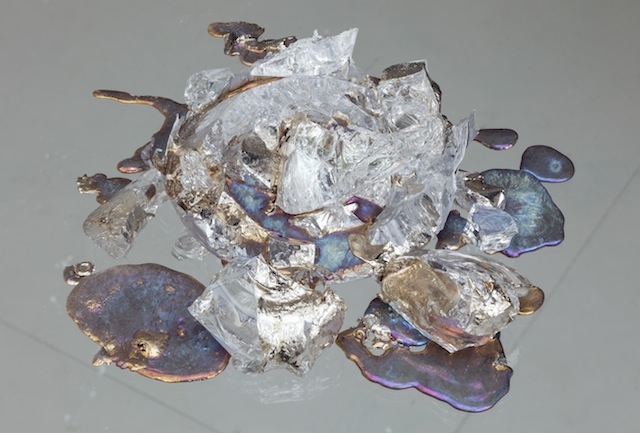‘Copper, iron and potassium aluminium sulfate growths on deep sea coral, fibre-optic cables in epoxy with patinated copper and plant pigments,’ reads the caption. It pertains to Shelf 1, a component of Ane Graff ’s work What Oscillates (2017), which was on view as part of the group show Myths of the Marble at the Henie Onstad Kunstsenter (HOK) in Oslo earlier this year. Four additional captions, accompanying four shelves, describe similar abundances of metals and minerals, many of which are components of the screen- based devices with and through which we go about our daily lives. Indeed, our smartphones contain at least 70 different elements, and it is precisely this material side of what is generally considered the immaterial virtual and digital sphere that interests Graff: from the reactions that occur when these materials are put into contact with one another, to the way in which tactility and the act of touching is at the core of the digital today.
Graff ’s captions, like doors in Narnia, take us to another place. Each component of the work itself resonates with potential: with possible reactions and transformations, depending on how it is connected to other components. Copper, integral to our communications infrastructure, is the most important material in this work. Malleable and conductive, it features in several different states, from crystal to fibre-optic tube to woven ribbon. The five shelves of What Oscillates rest on a suspended spindly structure made of steel and aluminium, displaying what look like five chemical experiments, each shimmering in silver and blue.
While taking a close look at the work in HOK’s somewhat James Bond-like building, I think of Donna Haraway’s version of ‘material semiotics’. Her methods suggest a way of making new combinations and collaborations, not just becoming something else, but ‘becoming-with’ – an idealistic way of dealing with the dilemma of individuals knowing either too much or too little. In her book Staying with the Trouble (2016), Haraway toys with the term sympoiesis as an extension and alternative to autopoiesis: ‘making-with’ rather than a (self-satisfied) self-making. Graff seems to try some of the making-with materially, by involving herself and various substances in a range of processes with mostly inorganic materials.
As small stages for molecular dramas, Graff’s shelves demand close inspection. The substances have had concrete encounters and altered each other, changing shape or colour, hardening and crystallising. They have been in touch, and through this process have changed identity. At the same time, they are also touched by humans, who restlessly finger their phones without knowing much about the materiality behind the screen. Although the term ‘digital’ is etymologically rooted in digitus, Latin for finger, you are not allowed to touch Graff’s sculptural microperformance. I have a hard time keeping my fingers away.
The fluidity of materials and how they interact returned in a new series of works by the artist titled Mattering Waves (2017), which was on view during the Bergen-based Entrée gallery’s guest appearance at Elizabeth Dee Gallery in New York this past April. There was a lot of blue and silver here, too. Seven Plexiglas trays were spread out on the floor, requiring you to kneel down to catch the details. While the viewer’s posture is thus more that of an archaeologist or a criminal investigator than the stereotypical gallery visitor, the trays themselves are reminiscent of both a chemical laboratory and the display cases of a jewellery shop. Mass-produced objects like glass bottles, silk gloves and a T-shirt neckband are absorbed by chemical processes, radically altered and turned into unexpected shapes and substances, appearing like a necklace or a giant snakeskin.
The caption for the third tray in Mattering Waves reads, ‘Epoxy and pigment covered hand-blown glass vessel filled with a mixture of polymer, dust, soil and human DNA, gallium, epoxy with mixed plant material, copper powder and synthetic pigments, Plexiglas and MDF base’. Here the human presence is integral to the work. Polymer literally exemplifies how things can be combined: a large molecule made up of smaller molecules, for example Styrofoam or DNA; it’s a combination that can be both synthetic and natural. Again the work is highly tangible, and it evokes the enchantment of science.
What Oscillates and Mattering Waves are both seductively beautiful to the eye. Simultaneously, they are much more than that. They perform ‘respons-ability’, as Haraway would describe it, seeking reactions and orchestrating unexpected encounters, concretely and materially.
From the May 2017 issue of ArtReview
